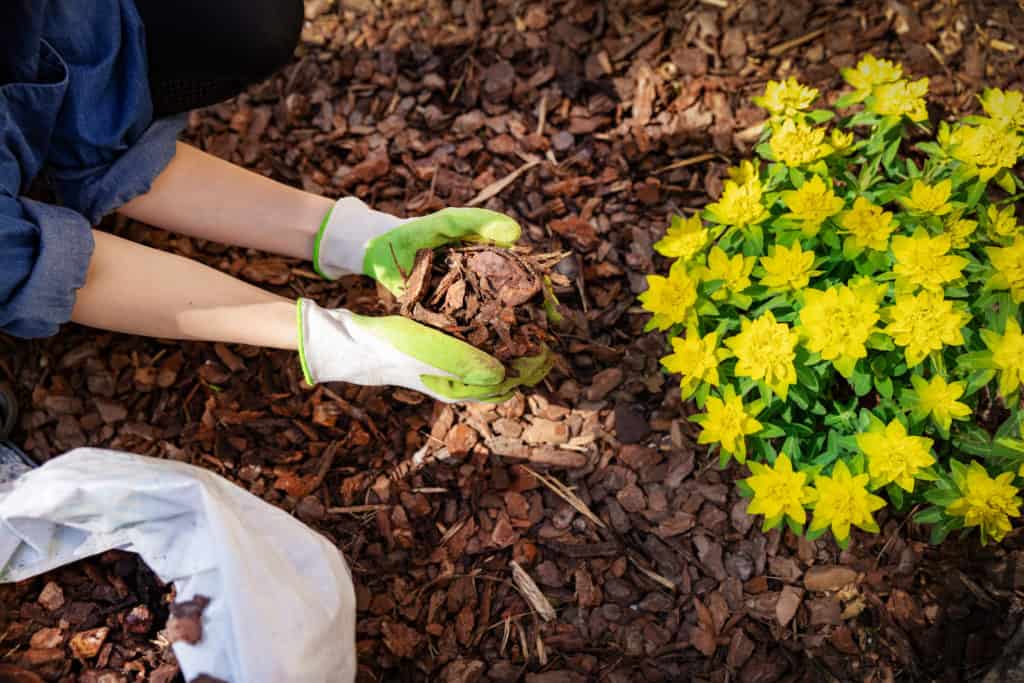Mulch is everywhere. It found around homes, businesses, parks, and more. It comes in various materials, colors, and sizes. Most of us likely know what it is when we see it, however, what is the purpose of mulch?
Table of Contents
Purpose of Mulch
- Weed Control – Mulch helps minimize the use of chemical weed control products that have the potential to harm the environment. A layer of mulch about 3 inches thick helps prevent sunlight from reaching the soil. Without sunlight, weeds have difficulty growing. The best types of mulch to use for weed prevention are inorganic materials such as rocks or rubber chips. According to the University of Massachusetts Amherst, non-organic mulches do not hold moisture, therefore the chance of weed germination is minimized since the seeds need water for growth. Additionally, lighter colored mulches are better than darker since they remain cooler and provide a less friendly environment for weed germination.
- Cool and Insulate Soil – The extreme heat and cold can damage or even kill your plants. In the harsh conditions of the summer, a mulch layer assists in keeping the soil cool. During the extremes of winter, mulch helps protect the roots from potential damaging temperature fluctuations by keeping the soil at a steady temperature.
- Moisture Retention – Mulch helps keep the underneath soil moist by blocking out the sun and wind that can quickly evaporate moisture. This helps to conserve water since the plants will need less manual watering. Use organic over inorganic mulch since it has been shown to demonstrate better moisture retention.
- Nutrient Creation – Organic mulch decomposes as it sits. While this means you will need to replenish your mulch from time to time, it also means that the decomposition process is providing nutrients into the soil from the organic material. This assists in keeping plants healthy and provides a means for them to thrive. Be aware that inorganic mulch such as rubber chips or gravel do not decompose to create nutrient rich soil, but will typically last much longer
- Curb Appeal – Adding mulch to landscape beds can dramatically improve the appearance of almost any yard. The colors and types of mulch are numerous, therefore, it is difficult not to find a kind that fits your landscaping needs.
Mulch Frequently Asked Questions
Organic mulch such as wood chips will last about 5-6 years before it fully decomposes. Inorganic mulch, such as rubber, can last 10 years or more but it lacks the benefits of organic mulch of providing nutrients to the soil. While mulch may last several years, its beautiful original color will likely fade. It is not uncommon for people to replace mulch every year or two years because of this color fading.
The cost of mulch is not cheap, especially if you pay a landscape company to install it. Even if you do it yourself you can expect to pay over $150 for 5 yards of mulch with delivery. Another disadvantage is that mulch can be a hiding place for animals and insects that you rather not have lingering around.
Wood mulch does provide a desirable moist environment for termites to move in once the mulch is placed down. You will increase your chances of termites with mulch around the home. This is not just specific to wood mulch, but any mulch that moistens the environment to allow termites to survive. In other words, the wood itself is not the attraction but rather the coolness and moisture the mulch offers.
It is not uncommon for weeds to grow right through the mulch if you do not pull them prior to placing it down. Start with a weed-free surface so you have no regrets in the future. It is much easier to pull weeds directly from the soil than through a few inches of mulch.
3 inches is the general rule of thumb for mulch thickness. Too thick of a layer will suffocate the plants and deter nutrients from gaining access to the soil. Too thin of a layer and the weed prevention properties of mulch are often diminished. When laying down new mulch, be sure to account for the thickness of the old mulch. Ask your landscape center the recommended thickness of the particular mulch you order.
No, mulch should be placed away from the base of plants to allow vital nutrient to reach the plant. This will also deter disease, rot, and pests from destroying the plants.
Plastic is not recommended but many people use landscape fabric. The combination of landscape fabric with an appropriate layer of mulch on top will often result in very few weeds. However, there are some disadvantage of using landscape fabric. It deters water from properly reaching the plant roots and does not allow organic mulch to decompose properly to provide nutrients. As time passes, the fabric will become weaker and provide less effective weed control.
Popular choices of organic mulch include wood chips, grass clipping, pine straw, leaves, and coca chips.
Examples of inorganic mulch include material such as rocks, rubber chips, and landscape fabric.
A layer of mulch over the grass can kill it. It prevents or limits the things the lawn needs for survival such as sunlight and nutrients. Keep the mulch off the grass if you do not intend to kill it. This includes when it is delivered.
Conclusion
There are several purposes of mulch, many of which are beneficial to plants. When you add these benefits to the beauty mulch can bring to a yard, it is often a no brainer to lay it down. Yes, it can be expensive depending on the type you buy, but if you are frugal you can get about two years out of it (more for inorganic mulch) before it will need to be replenished for aesthetic purposes. Happy mulching!

